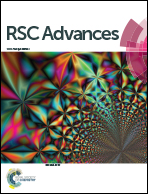Synthesis and pH-stimuli responsive research of gemini amine-oxide surfactants containing amides†
Abstract
The series of gemini amine-oxide surfactants with the formula CnH2n+1CONH(CH2)2N+O−(CH3)–(CH2)3–(CH3)N+O−(CH2)2NHCOCnH2n+1 (n = 11, 13, 15, and 17) has been synthesized successfully. Their isoelectric point and acid dissociation constant were measured to determine the ionization form of the surfactant molecules in aqueous solution within different pH values. The studies showed that the length of the hydrophobic alkyl chains had a great influence on the pH-stimuli responsive behavior of these surfactants. When n ≤ 13 (n-3-n-OA), the regularity of the pH-stimuli responsive behavior of the surfactant solutions was relatively consistent, while the surfactants with longer hydrophobic alkyl chain lengths lost this regularity (n ≥ 15). In addition, vesicles were observed in most of these surfactant aqueous solutions, with the exception of 11-3-11-OA. Moreover, the obvious flocculation phenomenon was observed within the range of pH 4–5, and they flocculated rapidly when they approached their isoelectric points. This process was reversible, which brought more possibilities for their application in drug delivery and release.



 Please wait while we load your content...
Please wait while we load your content...